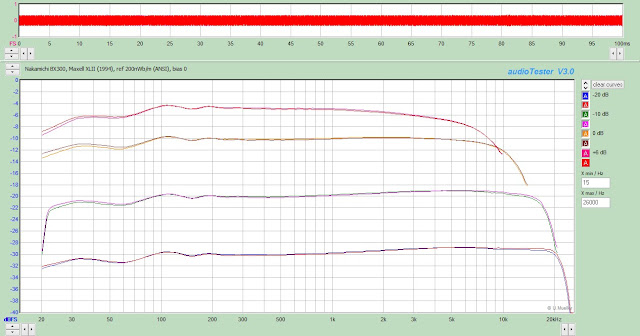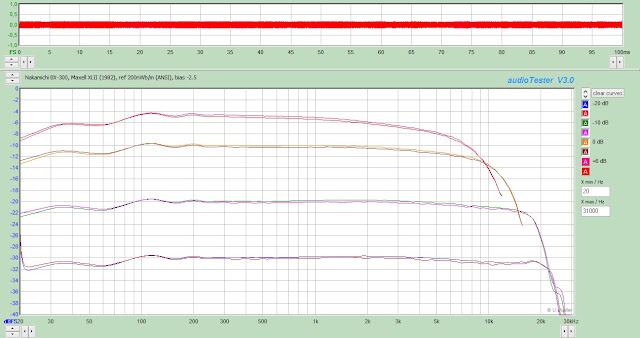Introduction
End of 2017 I purchased a good-condition Nakamichi Cassette Deck 1 (aka CD1), for no other reason than that I lusted after such machines back when I could not remotely afford them. I also always wanted to learn the real performance of the cassettes I so lovingly used in the 80s and 90s (first with a TEAC Black Plastic Cr*p deck, then with a CR-2), until CD-R and self-recorded DVD-A (yes!) wiped out everything. So in 2018 I embarked on a project of characterising all tapes I could lay my hands on. I did so first using the CD1, but after a while I changed over to a Nakamichi BX-300E, and I improved my measurement methods. You can find the details here.
This first series starts with my go-to tape of day one: Maxell's XLII.
The photographs are of the actual tapes used for the test, all purchased
in Europe. Many of these cassettes are very old now. Most were mine, and have been well taken care of, others come from unknown sources and show some wear.
Click on the graphs for a larger version.
Maxell XLII (1994) (what the deck was calibrated for)
Relative bias: (reference)Relative sensitivity: (reference)
THD @ Dolby level: 0.62%
MOL400(THD=1%) : +1.8dB
MOL400(THD=3%): +5.3dB
MOL1k(THD=3%): +5.5dB
SOL10k: -3.4dB
Bias noise: -54.8dB, -59.2dB(A)
Dynamic range: 64.5dB
I bought many of these at the end of my cassette era, shortly before moving over to DAT (an unwise decision that). Most of them remained unused or lightly used, so I chose them to be the standard type II tape to align to, for my own machines, as well as the decks that I refurbish and sell. (Later I switched to SXII, which is more robust and in line with IEC.)
Addition September 2019: and that was maybe not a wise choice. Contrary to some other generations this XLII diverges somewhat from the IEC II norm (U564W). In the meanwhile I have also looked at many more samples of these, and a great deal show a rising treble above and beyond what you see here. This may be a somewhat inconsistent tape; alternatively there may have been two different versions in its short life span, something hinted at in the 1994 and 1995 Hifi Choice cassette reviews you can download from this blog. I also found this XLII to be quite fragile: in their rush to ever lower bias noise levels the manufacturers, led by TDK, employed ever more aggressive polishing. This then led to long-term mechanical instabilities such as railroading or a high susceptibility to scratching.
All websites position this tape in 1994, but Hifi Choice January 1994 clearly states that it was launched Summer 1993, and that the actual tape in the months prior to this already had been loaded into 1991-type shells.
Maxell CR (1972)
Relative bias: -3.5Relative sensitivity: -1.9
THD @ Dolby level: 2.6%
MOL400(1%) : -5.4dB
MOL400(3%): +1.0dB
MOL1k(3%): 0.0dB
SOL10k: -7.2dB
Bias noise: -53.9dB, -57.7dB(A)
Dynamic range: 58.7dB
Maxell launched its first chromium dioxide tape in 1971, and updated it in 1972 and then again in 1974. The tape itself was probably the same in all of these versions.
I was lucky to find this sample in decent condition at the end of 2025, and had to wonder where to put it. Eventually I decided on this page, as CR is the obvious predecessor of UDXLII. Compared to some of the very oldest chromes I tested performance is remarkably good.
Maxell UDXLII (1977)
Relative bias: -2.5Relative sensitivity: +0.1dB
THD @ Dolby level: 1.7%
MOL400(1%) : -3.0dB
MOL400(3%): +2.6dB
MOL1k(3%): +2.4dB
SOL10k: -3.6dB
Bias noise: -52.7dB, -56.0dB(A)
Dynamic range: 58.6dB
Maxell's second ferro-cobalt 'epitaxial' tape (the first one was UDXL), and their first type II ferro-cobalt and foil to TDK's SA.
Beautiful, not? These were the first type IIs I bought in 1980 and I used them in an ITT portable. I had to ask my friends to record them for me on their parents' serious systems.
Bias had to be reduced a lot, yet sensitivity matches the more modern reference. There is 3.2dB more noise than the 1994 version, and MOL is 3dB lower. Together that gives a difference of 6dB in dynamic range. In other (simplistic) words: tape quality doubled in 24 years time.
It is interesting to compare with 1979 TDK SA. The Maxell has lower MOL but also lower noise. Moreover, there is a large difference in sensitivity between the two.
Maxell UDXLII (1980)
Relative bias: -2.5Relative sensitivity: +0.0dB
THD @ Dolby level: 1.8%
MOL400(1%) : -2.8dB
MOL400(3%): +2.1dB
MOL1k(3%): +2.0dB
SOL10k: -3.3dB
Bias noise: -52.3dB, -55.7dB(A)
Dynamic range: 57.8dB
The first UD-XLII model was in 1980 replaced with a seemingly identical cassette, but with a different wrapper (yellow replacing gold) and a less elaborate j-card (without the cutout). The actual tape appears to be still the same.
Maxell XLII (1982)
Relative bias: -2.5Relative sensitivity: +1.2dB
THD at Dolby Level: 0.72%
MOL400(1%): +1.3dB
MOL400(3%): +5.2dB
MOL1k(3%): +4.9dB
SOL10k: -4.1dB
Bias noise: -52.2dB, -55.6dB(A)
Dynamic range: 60.8dB
These were the first tapes I bought in large quantities. By that time I had graduated to an ITT music centre (with metal, Dolby, and LED meters ;-).
Maxell XLII (1985)
Relative bias: -2.5Relative sensitivity: 0dB
THD at Dolby Level: 1.5%
MOL400(1%): -1.2dB
MOL400(3%): +2.9dB
MOL1k(3%): +2.2dB
SOL10k: -3.9dB
Bias noise: -53.8dB, -57.8dB(A)
Dynamic range: 60.7dB
Maxell XLII (1986)
Relative bias: -1Relative sensitivity: +0.5dB
THD at Dolby Level: 0.76%
MOL400(1%): +1.2dB
MOL400(3%): +5.2dB
MOL1k(3%): +5.0dB
SOL10k: -3.6dB
Bias noise: -53.0dB, -56.7dB(A)
Dynamic range: 61.9dB
Maxell XLII (1988)
Relative bias: 0Relative sensitivity: +0.5dB
THD at Dolby Level: 0.69%
MOL400(1%): +1.6dB
MOL400(3%): +5.7dB
MOL1k(3%): +5.4dB
SOL10k: -2.6dB
Bias noise: -52.4dB, -56.4dB(A)
Dynamic range: 62.1dB
Maxell XLII (1990 JDM?)
Relative bias: -1Relative sensitivity: +0.5dB
THD at Dolby Level: 0.72%
MOL400(1%): +1.4dB
MOL400(3%): +5.5dB
MOL1k(3%): +5.5dB
SOL10k: -3.1dB
Bias noise: -52.9dB, -56.5dB(A)
Dynamic range: 62.0dB
This cassette came without j-card. At first I though it was the 1991 USA variant. However, the highish noise is more in line with 1988 XLII, making this perhaps the 1990 Japanese domestic market type.
Maxell XLII (1991)
Relative bias: -1.5Relative sensitivity: +0.4dB
THD at Dolby Level: 0.68%
MOL400(1%): +1.5dB
MOL400(3%): +5.1dB
MOL1k(3%): +5.0dB
SOL10k: -3.5dB
Bias noise: -54.6dB, -59.0dB(A)
Dynamic range: 64.1dB
This was the last epitaxial-based XLII, and seemingly the most IEC II compatible of the series.
Maxell XLII (1995)
Relative bias: -1Relative sensitivity: +0.6dB
THD at Dolby Level: 0.4%
MOL400(1%): +3.0dB
MOL400(3%): +6.3dB
MOL1k(3%): +6.4dB
SOL10k: -4.2dB
Bias noise: -55.2dB, -59.6dB(A)
Dynamic range: 65.9dB
The usual catalogueing websites tag this tape as 1998, but Hi-Fi Choice November 1995's tape special already features it, as does Stereo's August 1995 issue. Therefore 1995 it is.
More IEC II-compliant than the previous version. Compared to 1994 the MOL and noise have improved, but SOL has suffered a bit. This gives a staggering 66dB of dynamic range, much like 1990 and 1992 TDK SA-X. But due to the lower SOL this can only be exploited with music without too much treble.
Around 2000 this model was replaced with one with identical looks, but a welded shell.
Maxell XLII (2002)
Relative bias: 0Relative sensitivity: +0.2dB
THD at Dolby Level: 0.48%
MOL400(1%): +2.4dB
MOL400(3%): +6.0dB
MOL1k(3%): +5.8dB
SOL10k: -3.0dB
Bias noise: -54.6dB, -58.7dB(A)
Dynamic range: 64.7dB
The very last XLII. Not having a sample, this one confounded me for a while. So I purchased a few NOS ones. The wrapper makes one believe that there is a 1986-style shell in there, but it actually contains a 1998 shell in 1994 colour, with Peter Murphy in progress of being blown away.
I, however, was not. No matter where I measured on the tape, side A or B, beginning, middle, or end, in the BX-300 or in the CR-4, above 10kHz the left channel always lagged behind with 1 to 2dB. A second sample exhibited the same behaviour. Suspecting the shell I transplanted the tape to a 1990 SA, to no avail. Incidentally, this operation revealed that this version has a simpler slip sheet than the 1995 one.
Due to the compromised and variable treble performance finding the best operating point is not easy, and the same seems to have happened with the 1995 version, see above. This makes it hard to assess properly if the tapes themselves are identical between 1995 and 2002. The measurements are uncertain, the colours match, the smells don't, 2002 is quite odourless. A bit of a mystery, and certainly a bit of a disappointment.
Hitachi EX (1981)
Relative bias: -2.5Relative sensitivity: +0.3dB
THD at Dolby Level: 1.55%
MOL400(1%): -2.0dB
MOL400(3%): +2.6dB
MOL1k(3%): +2.2dB
SOL10k: -3.2dB
Bias noise: -52.1dB, -55.4dB(A)
Dynamic range: 58.0dB
Hitachi EX (1985)
Relative bias:-3.5Relative sensitivity: +1.6dB
THD at Dolby Level: 0.85%
MOL400(1%): +0.9dB
MOL400(3%): +4.9dB
MOL1k(3%): +4.2dB
SOL10k: -4.1dB
Bias noise: -52.9dB, -56.3dB(A)
Dynamic range: 61.2dB
For this series Hitachi copied the livery of the 1980 XLII-S for all of their tapes, including this XLII-class EX. The usual websites put this EX in 1988, but German magazine Stereoplay reviews it in April 1985. There, as well as here, it tests very close to 1982 XLII.
INDEX OF ALL CASSETTES




























